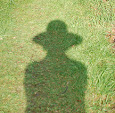It seems that this month of December 2009 is special. I was fascinated to hear on the radio yesterday the following item:
"Helen Mark [radio announcer] celebrates December's Blue Moon with artist Elspeth Owen, who is living outside and walking every night as part of an eccentric and unique project. When there are two full moons in one calendar month, the second of those moons is called a Blue Moon. Elspeth Owen, who is in her 70s, has decided to live outside between the first full moon (on the 2nd of December) and the second full moon (on the 31st). She wants to discover something about the dark, about fear and about using her senses differently."
(You can hear the whole radio programme by clicking here.)
"Helen Mark [radio announcer] celebrates December's Blue Moon with artist Elspeth Owen, who is living outside and walking every night as part of an eccentric and unique project. When there are two full moons in one calendar month, the second of those moons is called a Blue Moon. Elspeth Owen, who is in her 70s, has decided to live outside between the first full moon (on the 2nd of December) and the second full moon (on the 31st). She wants to discover something about the dark, about fear and about using her senses differently."
(You can hear the whole radio programme by clicking here.)
I thought a blue moon was just a song by Richard Rogers written in the 1930's.
So ... there is going to be a second full moon this month and the second time it appears is going to be on New Year's Eve!
So ... there is going to be a second full moon this month and the second time it appears is going to be on New Year's Eve!

A newspaper in Everett, Washington (here) states:
"The astronomical definition of a blue moon has nothing to do with the moon having a tinge of the color blue... It all has to do with mathematical odds. The synodic period of the moon, is 29.5 days. That’s the time it takes the moon to go through all its phases as it goes from evening crescent to full stage and back to morning crescent. That means we have a full moon every 29.5 days, and since the average length of a calendar month is little over 30 days, it’s bound to happen that we’ll have two full moons in one month every now and then."
(However, it was noted that but noted that the "two full moons in a single month" meaning couldn't be explained satisfactorily. Read about it here. Apparently the writer of an article in 1946 had misinterpreted a page of the 1937 Maine Farmers' Almanac.)
Finally, as to the term "blue moon", it appears to be that no one really knows for sure how the term evolved ... but it does shed some light (sorry about the pun!) on how we get the expression for a rare event happening "once in a blue moon".
____________________________________________
Photo: Flicker website here.
(However, it was noted that but noted that the "two full moons in a single month" meaning couldn't be explained satisfactorily. Read about it here. Apparently the writer of an article in 1946 had misinterpreted a page of the 1937 Maine Farmers' Almanac.)
Finally, as to the term "blue moon", it appears to be that no one really knows for sure how the term evolved ... but it does shed some light (sorry about the pun!) on how we get the expression for a rare event happening "once in a blue moon".
____________________________________________
Photo: Flicker website here.




No comments:
Post a Comment